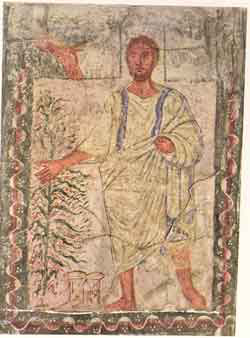The Scroll of Ruth deals with a bond, unique in the Bible; it is based on the mutual love and giving of two women. This bond is especially moving, since it is created within the context of their family tragedy and at the outset of their journey to a place never seen, on the one hand, and left long ago, on the other. From the depths of pain and depression, hope arises and blossoms, and with it the choice of life, activism and growth.
Ruth is the protagonist of the story: a strong, wise, sensitive and deep woman, who acts with dynamism in order to rebuild her life. Her strength of character, her faith and determination bring about a change in the attitudes of her mother-in-law Naomi and of her future husband, Boaz, toward her. Through the strength of her love, Ruth provides Naomi and Boaz with choice and creativity.
Ruth’s name is often linked to the word re’ut ‘friendship,’ since the Scroll of Ruth is widely held to exemplify grace. Another derivation of Ruth is from the word revaya ‘plentitude’:
Why was her name called Ruth? — Because there issued from her David who replenished the Holy One, blessed be He, with hymns and praises.
We present here an additional creative etymology by reading Ruth’s life story as ‘he-rut’, and therefore her book as the Scroll of Freedom: the freedom to choose and create, to build and to be built. And indeed, Ruth is independent, self-assured and filled with initiative, as is fit for the progenitress of the royal Judahite line. Ironically, this freedom sprouts “in the days of the Judges,” a period, in the biblical view, of chaos:
(ו) בַּיָּמִ֣ים הָהֵ֔ם אֵ֥ין מֶ֖לֶךְ בְּיִשְׂרָאֵ֑ל אִ֛ישׁ הַיָּשָׁ֥ר בְּעֵינָ֖יו יַעֲשֶֽׂה׃ {פ}
(6) In those days there was no king in Israel; everyone did as they pleased.
The art we will examine here, following the Scroll’s story line, includes a remarkable number of works by modern Jewish artists, evidence of the special attraction of this romance of the land of Israel. We will also consider works by Christian artists, both medieval and modern, looking for the personal interpretation of each one regarding the Scroll’s events and characters.
The Book begins with uprooting and death. Within the first three verses, Elimelech’s family (Naomi, Machlon and Chilion) leave famine ravaged Bethlehem, but are caught by cruel Fate in Moab and only Naomi and her new Moabite daughters-in-law survive.
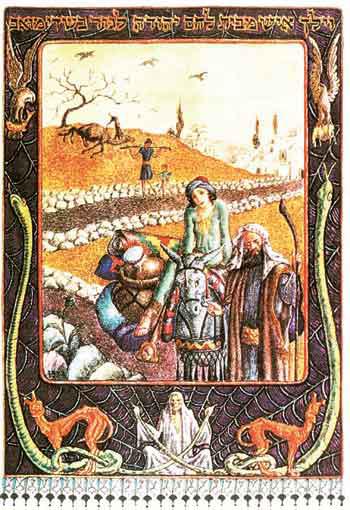
Zeev Raban, The Scroll of Ruth,
The Departure from Bethlehem, 1930
In the foreground of this first of Zeev Raban’s illustrations of the Scroll of Ruth, appear Naomi and her husband Elimelech. Their clothing, coloring and the use of a donkey for transporting their valuables testify to their elevated economic status. But their bodies are bent, they are sad and silent and each is sunk in his own thoughts. In contrast, the two boys in the background dart around, chattering and playing. However the landscape contains portents of doom: a withered tree, the carcass of a camel and birds of prey hovering over head. A path, dividing the picture in two, breaks off at an intersection, emphasizing the family’s change of course. They are trying to flee from death, and although it will soon catch them, eventually there will be a turn for the better. In the illustration’s frame are additional birds of prey, snakes and other wild animals; at bottom center, there is a skeleton. All of these figures, as well as the spider’s webs that fill the frame, further emphasize the as yet unperceived inevitability of doom.
According to the laconic biblical text, after Elimelech’s death Machlon and Chilion took Moabite wives, Ruth and Orpah.
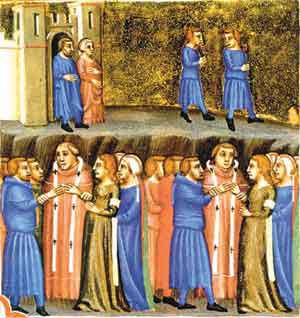
However, the painting above, from a fourteenth century Italian illuminated Bible adds to and changes the biblical account in accordance with Christian interpretation of the Book of Ruth. The picture contains two scenes. In the upper register, the sons leave their parents, although according to the biblical account, this occurred only after Elimelech’s death. One son looks forward enthusiastically; the other looks back longingly. Naomi holds her hand on her breast, expressing her sadness, her fear and her trepidation. In the lower portion of the picture, the impressive double wedding of Machlon and Chilion to Ruth and Orpah is performed by two priests, dressed as medieval Christian clergy. This wedding is not mentioned at all in the biblical account. A precipice divides the two scenes, portending the bitter fate awaiting the young men and in contrast to their present festivities. These departures from the biblical text were apparently guided by Christian allegorical interpretation of the characters as symbols of Judah and Israel (the sons) in exile and the foreign nations (their wives) that joined the Christian church.
After the death of her two sons, Naomi prepares to return to her homeland of Bethlehem, having heard that the famine had ended. Although her daughters-in-law want to accompany her, Naomi retorts bitterly that nothing will be gained by staying with her. The emotional farewell of the three women has evoked many artistic treatments. Usually, this scene is portrayed as an expression of love, grace and loyalty; but it also contains elements of irony, sarcasm and bitterness:
(יא) וַתֹּ֤אמֶר נׇעֳמִי֙ שֹׁ֣בְנָה בְנֹתַ֔י לָ֥מָּה תֵלַ֖כְנָה עִמִּ֑י הַֽעֽוֹד־לִ֤י בָנִים֙ בְּֽמֵעַ֔י וְהָי֥וּ לָכֶ֖ם לַאֲנָשִֽׁים׃ (יב) שֹׁ֤בְנָה בְנֹתַי֙ לֵ֔כְןָ כִּ֥י זָקַ֖נְתִּי מִהְי֣וֹת לְאִ֑ישׁ כִּ֤י אָמַ֙רְתִּי֙ יֶשׁ־לִ֣י תִקְוָ֔ה גַּ֣ם הָיִ֤יתִי הַלַּ֙יְלָה֙ לְאִ֔ישׁ וְגַ֖ם יָלַ֥דְתִּי בָנִֽים׃ (יג) הֲלָהֵ֣ן ׀ תְּשַׂבֵּ֗רְנָה עַ֚ד אֲשֶׁ֣ר יִגְדָּ֔לוּ הֲלָהֵן֙ תֵּֽעָגֵ֔נָה לְבִלְתִּ֖י הֱי֣וֹת לְאִ֑ישׁ אַ֣ל בְּנֹתַ֗י כִּֽי־מַר־לִ֤י מְאֹד֙ מִכֶּ֔ם כִּֽי־יָצְאָ֥ה בִ֖י יַד־יְהֹוָֽה׃
(11) But Naomi replied, “Turn back, my daughters! Why should you go with me? Have I any more sons in my body who might be husbands for you? (12) Turn back, my daughters, for I am too old to be married. Even if I thought there was hope for me, even if I were married tonight and I also bore sons, (13) should you wait for them to grow up? Should you on their account debar yourselves from marriage? Oh no, my daughters! My lot is far more bitter than yours, for the hand of the LORD has struck out against me.”
As we shall see, artists portrayed the relationship between the three women in a variety of forms, in accordance with their interpretations of the biblical account.
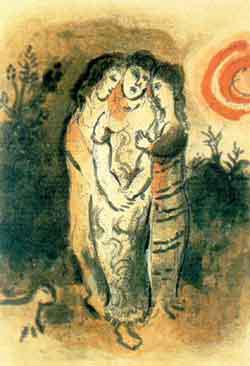
The three figures in Marc Chagall's lithograph seem to be in an embrace. But a closer look reveals that while the outer figures (the daughters-in-law) indeed hug Naomi, her arms are crossed and she does not return their embrace and remains solitary. In addition, her leg is extends forward, as if she wants only to continue on her way, to leave them, their embrace and her situation.
The figure to Naomi's right rests her hand gently on Naomi's breast; she is dressed in a striped gown that may identify her as Ruth. Looking at the background, we discover that on the right, behind Ruth, there are two shrubs and a red sun topped by two half circles. Behind Orpah, at left, there is much vegetation, some black echoing Orpah's black hair. Through these details of the background, Chagall hints at the coming separation.
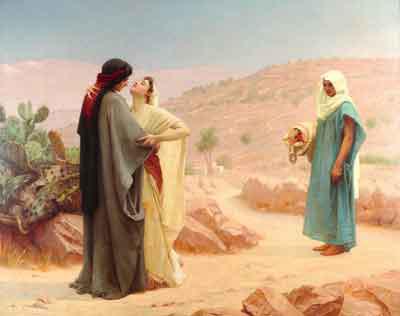
English artist Philip Hermogenes Calderon portrays the parting of the ways of Naomi and her daughters in law in a melodramatic tableau, fitting for a silent movie. His orientalist imagination places the three women in a dusty Palestinian landscape, replete with barren hills, spare palm trees, overwhelming Mediterranean light, rocks and a large prickly pear cactus. Orpah stands apart, having already said her goodbyes. She looks toward Ruth to accompany her. Ruth, on the other hand, clutches Naomi, in order to convince Naomi not to send her away.
(טז) וַתֹּ֤אמֶר רוּת֙ אַל־תִּפְגְּעִי־בִ֔י לְעׇזְבֵ֖ךְ לָשׁ֣וּב מֵאַחֲרָ֑יִךְ כִּ֠י אֶל־אֲשֶׁ֨ר תֵּלְכִ֜י אֵלֵ֗ךְ וּבַאֲשֶׁ֤ר תָּלִ֙ינִי֙ אָלִ֔ין עַמֵּ֣ךְ עַמִּ֔י וֵאלֹהַ֖יִךְ אֱלֹהָֽי׃ (יז) בַּאֲשֶׁ֤ר תָּמ֙וּתִי֙ אָמ֔וּת וְשָׁ֖ם אֶקָּבֵ֑ר כֹּה֩ יַעֲשֶׂ֨ה יְהֹוָ֥ה לִי֙ וְכֹ֣ה יוֹסִ֔יף כִּ֣י הַמָּ֔וֶת יַפְרִ֖יד בֵּינִ֥י וּבֵינֵֽךְ׃
(16) But Ruth replied, “Do not urge me to leave you, to turn back and not follow you. For wherever you go, I will go; wherever you lodge, I will lodge; your people shall be my people, and your God my God. (17) Where you die, I will die, and there I will be buried. Thus and more may the LORD do to me if anything but death parts me from you.”
Naomi, erect and unyielding in her mourning garb, looks down into Ruth's pleading face. The prominent cactus on the left is not only a feature of the environment, but it can also reflect Naomi's thorny mood, already revealed in the preceding the verses.
The intensity of the embrace and Naomi's stark, masculine look have engendered a homoerotic interpretation. We, however, view Calderon's portrayal in light of the artistic norms of the time: Ruth's exaggerated body language is offset by Naomi's glacial stance.
The same event is portrayed very differently by Dutch artist Pieter Lastman.
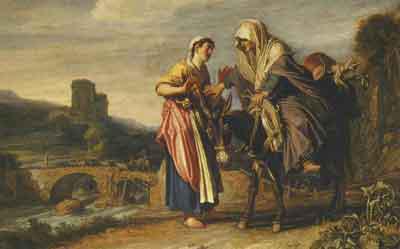
Here, Naomi pushes Ruth away in no uncertain terms. Her rejection of Ruth is not cold, but hostile; Naomi wants to clear her from her path. Naomi's face also betrays her bitterness. Ruth, for her part, raises her hands as if hurt and pleading, trying to thwart Naomi's uncompromising gesture. Ruth is dressed in red and blue, which mark saints in Christian iconography; perhaps she is being labeled as a martyr.
Another noteworthy feature of Lastman's painting is the donkey, unmentioned in the biblical account. Its addition places Naomi at a higher level (both in space and status) and facilitates the portrayal of her possessions. The donkey even expresses emotion; he lowers his head, listening to the exchange between the two women and sensitive to their situation. He does not appear bent on leaving Ruth, but plants his hooves in the ground.
Finally, in the background two buildings reflect the contentiousness of the two women. And the dilapidated bridge and the stream flowing beneath it appear to symbolize the transition and change in the lives of these women. On opposite bank, we can barely make out Orpah.
In summary, we have seen three interpretations of this farewell scene: Chagall joins the three women, but leaves Naomi in isolation; Calderon portrays Orpah as already detached from Ruth and Naomi, but Naomi seems distant too; and with Lastman, Orpah has almost disappeared, while Naomi is entirely alienated from Ruth.

Zeev Raban, The Scroll of Ruth,
The return to Bethlehem, 1930
In another of Raban's illustrations, Ruth and Naomi have reached Bethlehem; they enter the lively shuk like models on a runway, viewed from all angles, subject of wonder and gossip. The one carries her bundle with grace, the other with weariness.
(יט) וַתֵּלַ֣כְנָה שְׁתֵּיהֶ֔ם עַד־בּוֹאָ֖נָה בֵּ֣ית לָ֑חֶם וַיְהִ֗י כְּבוֹאָ֙נָה֙ בֵּ֣ית לֶ֔חֶם וַתֵּהֹ֤ם כׇּל־הָעִיר֙ עֲלֵיהֶ֔ן וַתֹּאמַ֖רְנָה הֲזֹ֥את נׇעֳמִֽי׃ (כ) וַתֹּ֣אמֶר אֲלֵיהֶ֔ן אַל־תִּקְרֶ֥אנָה לִ֖י נׇעֳמִ֑י קְרֶ֤אןָ לִי֙ מָרָ֔א כִּי־הֵמַ֥ר שַׁדַּ֛י לִ֖י מְאֹֽד׃ (כא) אֲנִי֙ מְלֵאָ֣ה הָלַ֔כְתִּי וְרֵיקָ֖ם הֱשִׁיבַ֣נִי יְהֹוָ֑ה לָ֣מָּה תִקְרֶ֤אנָה לִי֙ נׇעֳמִ֔י וַֽיהֹוָה֙ עָ֣נָה בִ֔י וְשַׁדַּ֖י הֵ֥רַֽע לִֽי׃
(19) and the two went on until they reached Bethlehem.When they arrived in Bethlehem, the whole city buzzed with excitement over them. The women said, “Can this be Naomi?” (20) “Do not call me Naomi,” she replied. “Call me Mara, for Shaddai has made my lot very bitter. (21) I went away full, and the LORD has brought me back empty. How can you call me Naomi, when the LORD has dealt harshly with me, when Shaddai has brought misfortune upon me!”
The abundance here of the shuk and the striding camel contrast with the bareness of the city and the carcass in Raban's picture of Elimelech's family departing. An additional contrast is created by the exuberant family atmosphere surrounding the two childless women. Finally, new leaves rustle in the frame suggesting immanent change of fortune.
After some time, Ruth goes out, by her own initiative, to glean the fields. Such work is characteristic of the poorest population, signaling the desperate situation of Ruth and Naomi as two destitute widows. Ruth comes, providentially or accidentally, to the fields of Boaz, a relative of Elimelech.
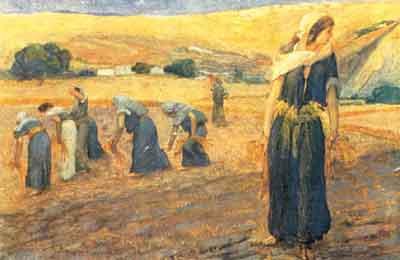
Except for Ruth's figure, James Tissot's painting is marked by a pastoral, everyday atmosphere with its earth colors and slow, orderly movement. In contrast to the other gleaners, bent over with their backs to the viewer, Ruth stands and waits nervously with just a few stalks of grain in her hands, as if she can already imagine what is about to happen. A triangle formed by the field in which the gleaners work points to the left, outside the frame of the painting, the same direction in which Ruth gazes, expecting (or noticing) Boaz's arrival; this correspondence of focus increases the feeling of expectation. On the one hand, Ruth is the protagonist of this picture; but she also acts as its director, standing apart in order to be noticed by Boaz.
And, indeed, he notices her, asks her identity and is told of her connection with Naomi. After granting her free reign to glean his fields, a conversation ensues, with mutual compliments, verging on courtship. Boaz even invites Ruth to eat with him and his workers.
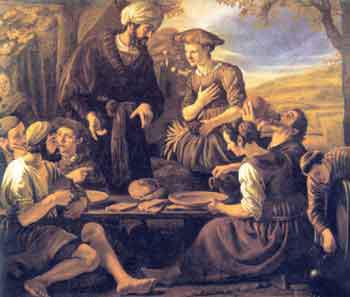
Jan Victors, Boaz entertains Ruth, 1653
In this painting by Dutch artist Jan Victors, Boaz, the host, attempts to put Ruth, the foreigner, at ease. She does not yet make eye contact with him, but modestly lowers her gaze and puts her hand to her breast in gratitude. All the other figures in this painting seem attentive in one way or another to the central couple. On the table, at the intersection of several triangles with which Victors' picture is constructed, lies a loaf of bread, alluding to the place of the event (Bethlehem, 'the house of bread') and to Ruth and Naomi's pursuit of economic support, which has led to Boaz.
Up to now, most of our pictures have been gentle, charming and earth colored, reflecting the general view of the book of Ruth as a pastoral romance. In contrast, an unknown sixteenth century illustrator chose to show the thorny side of life in the fields.
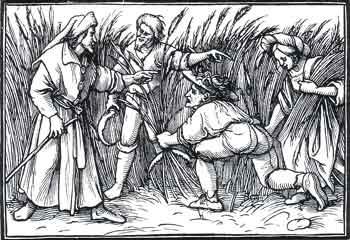
After lunch, Boaz gives orders to his people regarding Ruth
(טו) וַתָּ֖קׇם לְלַקֵּ֑ט וַיְצַו֩ בֹּ֨עַז אֶת־נְעָרָ֜יו לֵאמֹ֗ר גַּ֣ם בֵּ֧ין הָעֳמָרִ֛ים תְּלַקֵּ֖ט וְלֹ֥א תַכְלִימֽוּהָ׃ (טז) וְגַ֛ם שֹׁל־תָּשֹׁ֥לּוּ לָ֖הּ מִן־הַצְּבָתִ֑ים וַעֲזַבְתֶּ֥ם וְלִקְּטָ֖ה וְלֹ֥א תִגְעֲרוּ־בָֽהּ׃
(15) When she got up again to glean, Boaz gave orders to his workers, “You are not only to let her glean among the sheaves, without interference, (16) but you must also pull some [stalks] out of the heaps and leave them for her to glean, and not scold her.”
There's nothing gentle in this woodcut. Sharp points and angles characterize plants, tools and people. The harvesters are ruffians, with aggressive postures and gestures, as opposed to the civil Boaz and Ruth. Who knows what would happen to a woman gleaning in the fields, without such strong words of warning from a superior.
When Ruth returns home from gleaning loaded with grain, the family connection with Boaz is revealed.
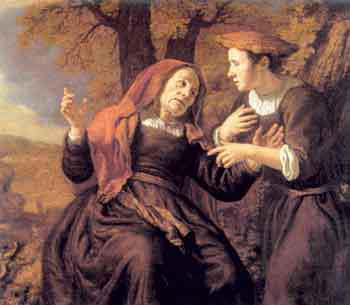
Another Jan Victors painting describes the intimate meeting of Ruth and Naomi to plan the strategy that will fulfill (see the key word רויה) the quest for security and continuity. Naomi takes the active role:
(א) וַתֹּ֥אמֶר לָ֖הּ נׇעֳמִ֣י חֲמוֹתָ֑הּ בִּתִּ֕י הֲלֹ֧א אֲבַקֶּשׁ־לָ֛ךְ מָנ֖וֹחַ אֲשֶׁ֥ר יִֽיטַב־לָֽךְ׃ (ב) וְעַתָּ֗ה הֲלֹ֥א בֹ֙עַז֙ מֹֽדַעְתָּ֔נוּ אֲשֶׁ֥ר הָיִ֖ית אֶת־נַעֲרוֹתָ֑יו הִנֵּה־ה֗וּא זֹרֶ֛ה אֶת־גֹּ֥רֶן הַשְּׂעֹרִ֖ים הַלָּֽיְלָה׃ (ג) וְרָחַ֣צְתְּ ׀ וָסַ֗כְתְּ וְשַׂ֧מְתְּ (שמלתך) [שִׂמְלֹתַ֛יִךְ] עָלַ֖יִךְ (וירדתי) [וְיָרַ֣דְתְּ] הַגֹּ֑רֶן אַל־תִּוָּדְעִ֣י לָאִ֔ישׁ עַ֥ד כַּלֹּת֖וֹ לֶאֱכֹ֥ל וְלִשְׁתּֽוֹת׃ (ד) וִיהִ֣י בְשׇׁכְב֗וֹ וְיָדַ֙עַתְּ֙ אֶת־הַמָּקוֹם֙ אֲשֶׁ֣ר יִשְׁכַּב־שָׁ֔ם וּבָ֛את וְגִלִּ֥ית מַרְגְּלֹתָ֖יו (ושכבתי) [וְשָׁכָ֑בְתְּ] וְהוּא֙ יַגִּ֣יד לָ֔ךְ אֵ֖ת אֲשֶׁ֥ר תַּעֲשִֽׂין׃
(1) Naomi, her mother-in-law, said to her, “Daughter, I must seek a home for you, where you may be happy. (2) Now there is our kinsman Boaz, whose girls you were close to. He will be winnowing barley on the threshing floor tonight. (3) So bathe, anoint yourself, dress up, and go down to the threshing floor. But do not disclose yourself to the man until he has finished eating and drinking. (4) When he lies down, note the place where he lies down, and go over and uncover his feet and lie down. He will tell you what you are to do.”
Ruth listens intently and agrees to act. The rapid movement of hands reflects the intensity of the dialogue and the growing closeness of the women, reflected in their similar dress. This picture expresses the three plays on Ruth's name: friendship (רעות (, their power of independent decision (חירות) leading toward the third concept, fulfillment (רויה).
Following Naomi's directions, Ruth comes to the threshing late at night and crawls under Boaz's cover. This scene has elicited many artistic renditions. We will ask, regarding each of three under discussion, which exact moment of the scene is portrayed and what is the artists reading of it?
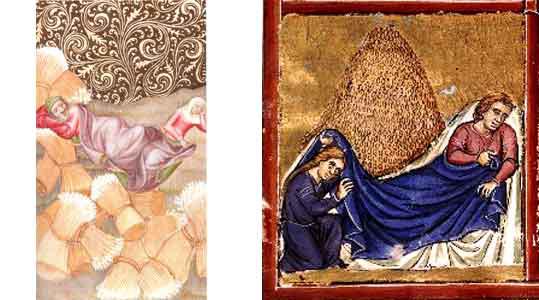
Ruth and Boaz Ruth and Boaz
at the threshing floor, at the threshing floor,
1390 - 95 1250 - 54
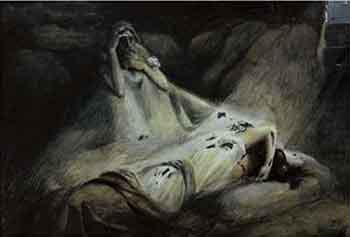
1896 - 1900
In the earliest of our selections, the illustrator of the Arsenal Bible of 1250 has chosen the moment in which Ruth "uncovers Boaz's feet". Boaz is a young man; he lies at the foot of his erect heap of grain. In the other two pictures, a later point in the scene is portrayed: the moment at which Boaz wakes to find Ruth lying at his feet or after their nocturnal conversation.
In the Wenzel Bible of circa 1390, Ruth has gone back to sleep after her encounter with Boaz, in which he has promised to redeem Naomi's property through his marriage to Ruth. An older Boaz is left to internalize the full significance of his commitment and to plan his next moves. His facial expression reflects perplexity; either he is wondering if this is really happening or he is trying to figure out his next move. Ruth sleeps, since she has performed her task and is nearing the fruition of her hopes. Boaz, however, now needs to act. He is wakeful, since he must complete his mission—to deal with Naomi's next of kin and marry Ruth. His deliberations are also reflected in the swirling background that further evokes the complex and winding paths linking the couple. In the lower part of this painting, the many sheaves of grain seem to presage the couple's bounteous future.
James Tissot's watercolor is the most mystical and spiritual of the three renditions. An old man is engulfed in the light and aura of possibilities not even imagined. The painting is built around a well-lit triangle, formed at its base by Ruth's reclining body that exudes intimacy and even seduction; its apex is formed by Boaz's head and arms, expressing frozen shock. The strip of light illuminating the triangle from above may represent God's watchful approval. Thus, the triangle is composed of the human couple and the divine presence, and symbolizes the marriage covenant being formed. While the figures are already clothed, they are also veiled in light.
In summary, our three renditions of the threshing floor scene, the height of the book's romance, describe varying moments using different colors, lighting and characterization.
After their engagement, but before daybreak, Boaz measures out a generous supply of grain for Ruth to take home.
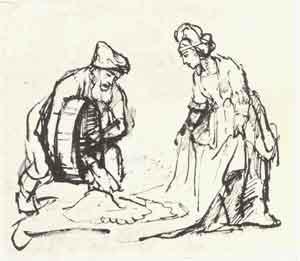
Earlier, in a subservient position, Ruth now supervises. Boaz bends with the weight of his bounty.
Before the romance can continue, however, there is business to complete. In a classic scene of judgment at the gate, the anonymous closer relative is offered first refusal of Naomi's property, but is stopped by the clause that imposes Ruth on him. His refusal to take on this added burden is marked by the ancient rite of halitzah, the removal of the shoe.
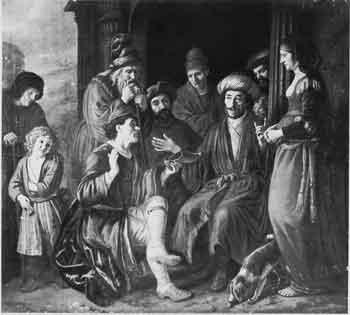
Jan Victors, Boaz receives the redeemer's shoe
In this third painting by Jan Victors, ten figures are seen, amongst them two women and a child (an egalitarian minyan!). At the center, the recalcitrant relative sits holding his shoe, his white feet highlighting the ceremony. Boaz sits opposite gesturing to signal the successful conduct of the plan, while Ruth stands to the side, barefoot and with a dog beside her—two artistic conventions of the time, connected with marriage scenes.
The final scene in the book of Ruth is the birth of Obed, King David's grandfather.
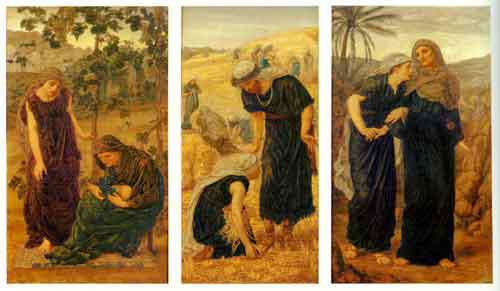
In Thomas Rooke's triptych, two figures in each panel define the three turning points in Ruth's story, reading from right to left. First, Ruth takes the assertive role in creating a new relationship with her bereaved mother-in-law. In the center, Ruth sets up the chance meeting with Boaz, her benefactor. Finally, the new mother participates in the joy of the new grandmother, the happy end. Friendship, independence and fulfillment have defined Ruth's name.
For additional images on this subject see TALI Visual Midrash



